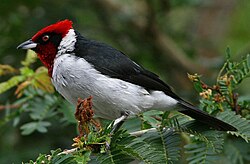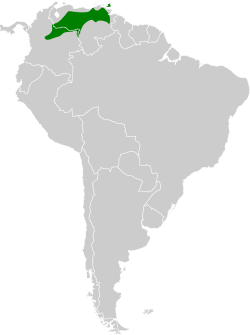| Masked cardinal | |
|---|---|
 | |
| Scientific classification | |
| Kingdom: | Animalia |
| Phylum: | Chordata |
| Class: | Aves |
| Order: | Passeriformes |
| Family: | Thraupidae |
| Genus: | Paroaria |
| Species: | P. nigrogenis |
| Binomial name | |
| Paroaria nigrogenis (Lafresnaye, 1846) | |
 | |
| Synonyms | |
Paroaria gularis nigrogenis | |
The masked cardinal (Paroaria nigrogenis) is a bird species in the tanager family (Thraupidae). It is not very closely related to the cardinals proper (Cardinalidae).
It is found in Trinidad, far north-eastern Colombia, and northern Venezuela. It was previously considered conspecific with the red-capped cardinal (Paroaria gularis), from which it differs by the black ear-coverts and the red (not black) lower throat and upper chest. Additionally, its lower mandible is typically whitish, but this is not entirely consistent, as it occasionally is pale flesh-coloured. This distinctive taxon is a distinct species, as suggested by the lack of hybridization with P. g. gularis in the limited area of overlap in southern Venezuela. [2] [3] The common name masked cardinal was suggested. [4]
